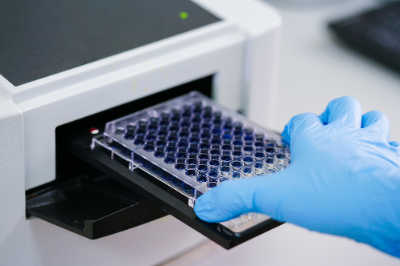What Is ELISA?
 ELISA is a method for qualitative and quantitative analysis of proteins, such as antigens and antibodies present in liquid solutions. ELISA is an abbreviation for enzyme-linked immuno sorbent assay and is a type of immunological assay. ELISA utilizes the specificity of antigens and antibodies and is a highly accurate method for both qualitative and quantitative analysis.
ELISA is a method for qualitative and quantitative analysis of proteins, such as antigens and antibodies present in liquid solutions. ELISA is an abbreviation for enzyme-linked immuno sorbent assay and is a type of immunological assay. ELISA utilizes the specificity of antigens and antibodies and is a highly accurate method for both qualitative and quantitative analysis.
ELISA is widely used for quantitative analysis of antigens and antibodies, as commercial kits are available. In general, temperature control is important for ELISA kits, so care should be taken to ensure that the kits are not kept at extremely different temperatures depending on the location of the refrigerator where they are stored, or that they are not frozen due to excessive cold.
Depending on the method, ELISA may require many steps before quantitative analysis, but recently, fully automated analyzers have been developed, and the time required for analysis has been reduced.
Uses of ELISA
ELISA is widely used in the field of biotechnology. For example, ELISA is used for analyzing antigens and antibodies in blood, such as plasma and serum. By collecting blood samples and measuring the values of autoantibodies in ELISA, it is possible to diagnose diseases or to determine antibody titers due to vaccination. For this reason, ELISA is widely used in the analysis of blood tests performed in hospitals, and even recently, more and more diseases have been identified by ELISA through research.
It can also be used to determine the presence or absence of allergens in food, or to determine the presence or absence of food allergies by collecting blood samples from the subject.
While the PCR method using DNA has become well known as a test for coronavirus antigens and antibodies, ELISA analysis is also available in kits and other forms.
Principle of ELISA
ELISA uses an antigen-antibody reaction to perform the analysis.
First, the antigen to be measured is combined with an antibody that has specificity to the antigen. To detect the bound antibody, an antibody labeled with a specific enzyme is further bound.
The antigen, antibody, and enzyme-bound substance to be measured are then mixed with a substrate that reacts with the enzyme to produce a color change. The color tone changes in accordance with the amount of the substance to be measured, and the absorption spectrum is measured using an absorbance spectrophotometer for quantitative and qualitative analysis.
IgG antibodies are often used in immunological assay methods, including ELISA.
ELISA Methods
There are several methods of ELISA, and many types of kits are available. The simplest direct method is introduced here. The basic flow of measurement is not much different from others.
First, an antibody that binds to the substance to be measured is adsorbed on a microplate.
A defined amount of liquid sample is added to the microplate using a pipette. The temperature is controlled in an incubator, and the sample is allowed to react and bind to the antigens and antibodies on the microplate. Excess antibodies are washed away.
The bound antibodies are further reacted by specific enzymes. To detect enzyme activity, a substrate with a different absorption spectrum when bound to the enzyme is added, and the absorption spectrum after the reaction is measured and analyzed. In many cases, peroxidase (HRP) derived from horseradish is used as a substrate for color development, and care must be taken to avoid using blood collection tubes coated with sodium azide or other inhibitors when using HRP.
Finally, the absorption spectrum is measured and analyzed using an absorbance spectrophotometer.
ELISA Equipment
ELISA often requires many steps for accurate analysis depending on the substance to be measured, and each step is repeated, such as aliquoting and washing. Pipettors, microplates, incubators, absorbance analyzers, etc. are also required.
Recently, devices have been developed that enable a single unit to perform all roles, from pipetting to absorbance analysis. The ability to perform measurements fully automatically, without human intervention, reduces errors and saves time and labor.